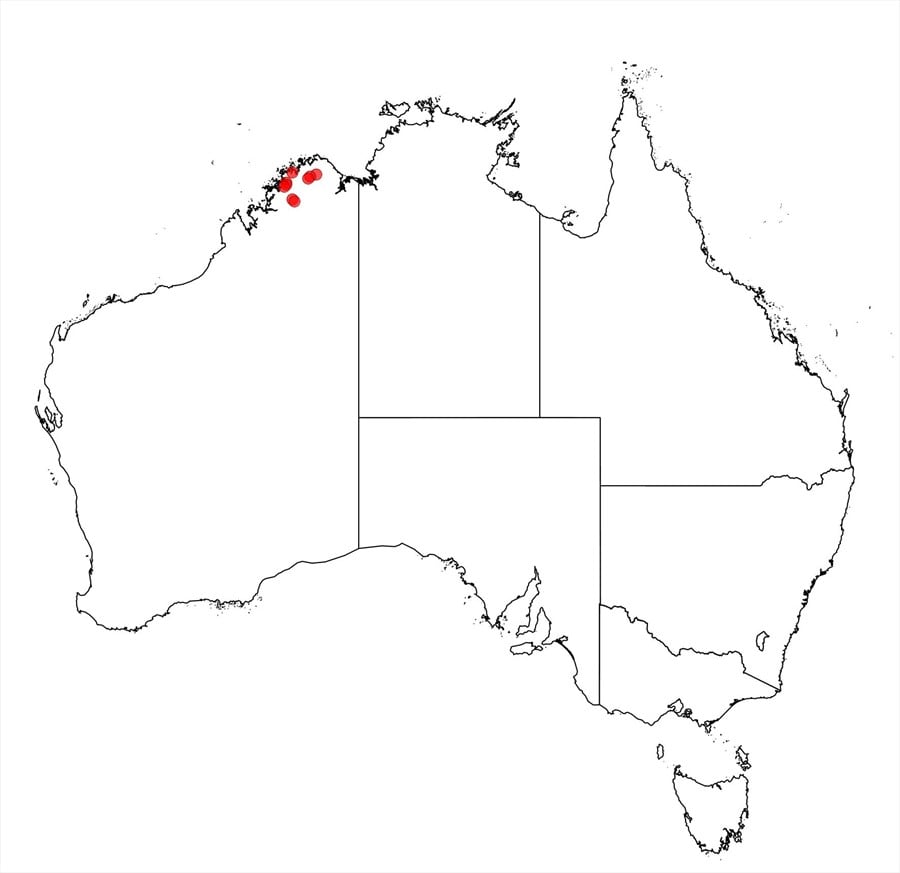Acacia diastemata Maslin, M.D.Barrett & R.L.Barrett
WATTLE
Acacias of Australia
Common Name
Sandstone Pavement Wattle
Family
Fabaceae
Distribution
Occurs in the Kimberley region of northern W.A. where it is known from widespread but very localised populations between the Prince Regent R., N to the Roe R., and E to Drysdale R. Natl Park. Its geographic range extends over c. 200 km along a SW/NE axis.
Description
Erect shrub or small tree 2–5 m tall. Bark fibrous, grey. Branchlets finely ribbed, brown aging grey, glabrous. Phyllodes narrowly linear, 9–16 cm long, 1–2 mm wide, apex terminated by a blunt, callous point, thin and pliable, erect, straight to shallowly incurved, glabrous; longitudinal nerves 3, widely spaced, the often yellowish central nerve the most pronounced; gland basal, very small. Peduncles 1.5–3 (–4) mm long, glabrous; spikes 25–35 mm long, interrupted, light golden. Flowers 4-merous or sometimes 5-merous; calyx gamosepalous, shortly dissected into broadly triangular lobes, calyx tube glabrous. Pods glabrous, narrowly linear, slightly constricted between seeds and obviously rounded over them, 4–7 cm long, 2–2.5 mm wide, thinly coriaceous-crustaceous, obscurely longitudinally reticulately nerved. Seeds longitudinal, obloid, 2–2.5 × 1.2–1.4 mm; areole elongated ‘u’-shaped; aril bright yellow or sometimes cream (at least when dry).
Phenology
Because of the paucity of collections it is not possible to accurately determine the phenology but flower have been collected in late Jan. and mature seed in late Mar. and May. It seemingly flowers in the wet season and fruits in the early dry season.
Habitat
Occurs in small stands on massive sheeting sandstone pavements and grows with a range of species including Acacia kenneallyi, Goodenia aff. gloeophylla, Hibiscus superbus, Macarthuria vertex, Triodiaspp. and Triumfetta spp.
Specimens
W.A.: [localities withheld for conservation reasons] R.L.Barrett & M.D.Barrett MDB 1372 (BRI, MEL, NSW, PERTH); M.D.Barrett & R.L.Barrett MDB 1843 (AD, BRI, CANB, DNA, G, MEL, NSW, NT, NY, PERTH).
Notes
Flower merosity is variable, which is unusual in Acacia. Within a single spike the flowers can be either all 4-merous or a mixture of 4-merous and 5-merous.
Most closely related to A. scopulorum (from N.T.) which is readily distinguished by its wider phyllodes with more numerous nerves. The 4-merous flowers with gamosepalous calyces, that are arranged in long, interrupted spikes, suggest that both these species are related to the ‘A. longifolia group’ from SE Australia; see A.G.Brown et al., Systematic Botany 23: 162-172 (2010), for discussion of this group. In having narrowly linear, 3-nerved, glabrous phyllodes A. diastemata is remarkably similar to narrow phyllode forms of A. longissima from this group. Acacia longissima, which occurs in SE Qld and northern N.S.W., is distinguished by its eglandular phyllodes, narrowly ellipsoid, much larger seeds, densely tomentulose ovaries and commonly longer peduncles.
Conservation
Acacia diastemata is listed as Priority Three under Department of Parks and Wildlife Conservation Codes for Western Australian Flora.
FOA Reference
Flora of Australia Project
Author
B.R.Maslin
This identification key and fact sheets are available as a mobile application:
URL: https://apps.lucidcentral.org/wattle/
© Copyright 2018. All rights reserved.






